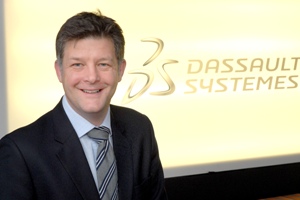Auto industry challenged by move from selling vehicle ownership to selling transport services

Stephen Chadwick, managing directorDassault Systèmes
The automotive industry has faced no challenge so great as today’s. Many production, safety, performance, quality and technology quandaries have been solved. But now the bar has been raised again by significant changes in consumer demand patterns.
The current diversity of products and a demand for ‘transport’ rather than ownership has set the transport industry new technical and commercial challenges.
Transport ownership in cities is becoming more expensive and less desirable as public and shared transport improves. New ways of achieving transport are being introduced into cities with great success. It is now possible in many cities to use pedal bikes, electric and other internet bookable vehicles almost as though they are self-owned, with convenience and flexibility but no ownership responsibility or fixed costs, says Stephen Chadwick, managing director, Dassault Systèmes EuroNorth.
A van one day, a mini and a bike the next and nothing the day after is the ideal for many city dwellers. Prohibitive insurance prices for young motorists add to the attraction of non-ownership.
Recently Ford launched its Ford Smart Mobility start-up. Quoted in the Guardian Mark Fields, Ford’s CEO called it part of “Rethinking our entire business model” He said that Ford understands that the world has changed from a, “Mindset of owning vehicles to one of owning and sharing them”.
In September, last year, Ford bought the shuttle business Chariot. Innovatively, Chariot’s routes are crowd-sourced by passenger demand while algorithms dynamically work out the most efficient way to offer the best transport service to everybody.
This new venture somewhere between a bus and a taxi is being trialled in San Francisco in advance of what is expected to be a global expansion.
In the UK transportation, mobility and the companies behind it are changing with new technologies and usage models. By 2030 a £50bn(US$ 62.85 billion) boost to the UK economy from autonomous and connected vehicles is predicted by The Society for Motor Manufacturers.
The vehicle industry is buzzing with innovations. August 2016 saw the £2bn(US$ 2.51 billion) acquisition of Nokia‘s ‘Here’ vehicle location mapping business by a group of automotive companies. This will lead to “highly automated driving” according to Nokia chief executive, Rajeev Suri.
David Bailey, professor of industry at Aston Business School in Birmingham was quoted in the Guardian saying, “There are more and more autonomous features being developed all the time and the technology is transforming the industry.”
Many mobility companies are using simulation technology to take out risk from their development decisions. They do this by simulating not only the design and manufacture of their products but also their usages. In this way companies are able to innovate with a broader range of options because technology allows them to factor in many more what-if scenarios.
Simulating these processes and activities indicates where improvements can be made and where potential problems lie. By intelligently connecting people, customers and partners to reduce resource redundancies, complexity can be mastered. This puts manufactures into a situation of being able to offer more attractive options to their customers – with less risk and cost to themselves.
These technologies and systems are changing the way people behave and how they perceive and use their transport and mobility options within a bigger picture. Transportation users become involved in the innovation process when providers listen to and understand ‘social noise’ on the Internet. By interpreting and acting on this level of customer feedback providers are able to develop more desirable products and services.
Another major change is the cross-discipline movement between city planners, builders, energy management and transportation professionals.
The coming together of these formerly diverse disciplines holds new challenges and risks for the mobility industry which must re-define its value capture models and perhaps its entire method of operation. To manage this change, traditional static and hierarchical business structures are being replaced by new dynamic collaboration models – a move that needs to accelerate.
Today’ consumers favour experiences over products. Consumers want new levels of service but not necessarily ownership. Successful transportation manufactures are already adapting to meet the revolutionary changes of society by re-imagining their eco-system.
Manufactures’ ability to accommodate the future lies in adopting new IT models that let them become mobility providers. There is no single solution to mobility. The market, and the products and services that supply it, are becoming ever more diverse. Meanwhile existing and new transportation systems are developing both independently and interdependently.
Mobility can be an emotional and social experience that varies widely across the world. To capture market share, providers must appeal to those emotions and communities by crossing boundaries to discover new ideas to validate and then turn them into tomorrow’s profitable products and services.
The author of this blog is Stephen Chadwick, managing director, Dassault Systèmes EuroNorth
Comment on this article below or via Twitter @IoTGN
